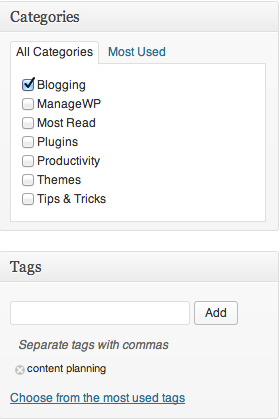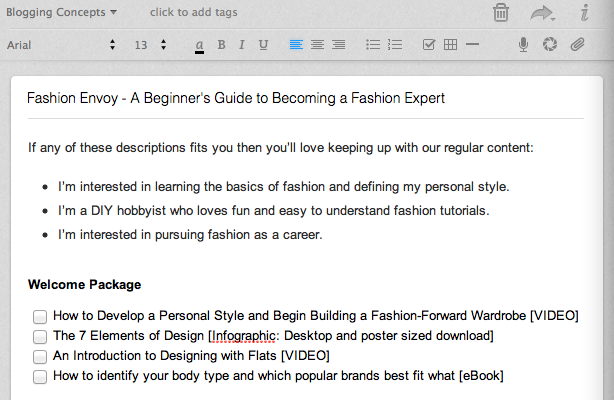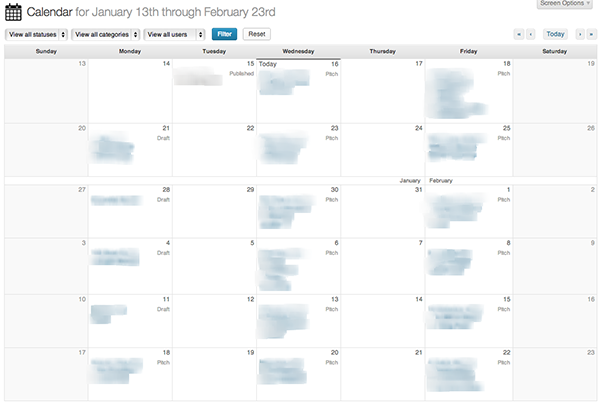
There are some inherent challenges that come with maintaining a blog. One of them is making sure you always have new post ideas.
Whether you write for yourself or for others the task of continuously coming up with new post ideas can become daunting (not to mention time consuming) and the temptation can be to resort to boring formulas or meaningless list posts in order to keep things rolling. But as anyone knows who’s been “tricked” into clicking on a link they think will provide interesting and/or useful information knows, bland content is possibly more damaging to a blog (particularly its community development) than no content at all.
So what’s the answer? How do you make sure you have consistently useful and/or meaningful post ideas for your blog without wracking your brain for hours on a weekly basis?
Personally, I don’t think that there’s any one right answer to those questions, but in the post below I’m going to share a method with you that I’ve developed over the last couple of years that takes about 90 minutes to complete and can result in months worth of awesome blog post ideas.
Interested? Then keep reading!
Step 1: Re-visit Your Blog’s Basics
At the core of every successful blog there is an understanding of a few basic elements:

Main Topic(s)/Categories/Tags
 As a general rule every blog should have a main topic or topics with categories and tags serving as an efficient means by which site visitors (and search engines for that matter) can navigate to relevant pieces of content about the main topic(s).
As a general rule every blog should have a main topic or topics with categories and tags serving as an efficient means by which site visitors (and search engines for that matter) can navigate to relevant pieces of content about the main topic(s).
Take this post for example: ManageWP (blog) > WordPress (Main Topic) > Blogging (Category) > Content Planning (Tag).
If your blog is not setup with a laser-like focus on just one or a few related topics then that could be the reason conceiving posts has proved to be a challenge in the first place. It’s the difference between someone going, “Hey draw me something” versus “Hey draw me a mahogany bookcase full of leather-bound classics.”
While I’m not sure why you would want to draw a mahogany bookcase full of leather-bound classics in the first place, there’s no denying that it is the existence of those details — we’ll call them constraints — that make the task of getting started much easier than the task of drawing something as elusive as anything you want. Likewise, it is the constraints of a blog topic with categories and tags that make producing meaningful content much easier than attempting to pull useful ideas out of thin air.
For more details on how to setup your categories and tags check out these posts: The Right Way to Use Categories and Tags in WordPress and WordPress Tags: Everything You Need to Know.
Unique Selling Proposition
A unique selling proposition (USP) is that special thing that makes your blog or business stand out from the crowd. It is the answer to the question, “Why should I be reading your blog?”

If you’re not exactly sure what that means or if you’re unsure how to find your own USP I highly recommend that you check out this post over at Think Traffic: The Ultimate Guide to Finding Your Unique Selling Proposition.
Brand/Voice/Audience
 I know that there is much more to branding than the voice you choose to use when composing content for your blog, but it is an important part of your brand. Besides your design and presentation, the way in which you choose to talk (write) to your audience will determine who is able to connect with you and often how they will respond in turn. This goes hand in hand with knowing your audience. If you are unaware of how best to communicate with your target audience then it’s probably time to do a bit more research.
I know that there is much more to branding than the voice you choose to use when composing content for your blog, but it is an important part of your brand. Besides your design and presentation, the way in which you choose to talk (write) to your audience will determine who is able to connect with you and often how they will respond in turn. This goes hand in hand with knowing your audience. If you are unaware of how best to communicate with your target audience then it’s probably time to do a bit more research.
And I feel it’s important to note that when someone says the word “research” in terms of finding your target audience, it is not some grand mysterious process. Find some websites, magazines, tv shows, movies, etc. that appeal to the type of person you want to talk to. Study them. Learn about your audience through them. And then talk to your target audience in terms they are familiar with and will respond to.
As the conversation continues adjust your tone and subject matter according to the response you get. Just like you would if you were in the same room with a group of people having a conversation in person.
Put It All Together
If you’ve never taken the time to figure these things out and write them down then your first step in coming up with consistently useful and meaningful post ideas is to do just that. This is a prerequisite for my method and it’s important to get this information right before moving forward.
If you have considered these things before then it’s a good idea to re-visit them by pulling up that file and reminding yourself about the core focus behind your blog — the reason you started it in the first place.
Step 2: Get Organized
Ok, so now that the somewhat lengthy step one is complete you are ready to begin my content planning process. As the title of this post would suggest it’s quite simple. You can get started with just a blank piece of paper and a pen but I prefer to use the desktop and mobile app Evernote.

Whatever materials you choose to use, here is what you do:
- Title your page with the name of your blog.
- Under the title write or copy and paste your main topic(s) and unique selling proposition. In some cases this will take the form of a carefully crafted tagline.
- Jot down a quick note on your voice and audience so that as you come up with ideas you are reminded of the tone you aspire to.
- Create a series of headings by listing your blog categories with space beneath each for at least five post ideas.
Now you’re ready to brainstorm!
Step 3: Content Planning – Brainstorming & Research (90 mins)
 As I mentioned in the final bullet point above, I like to set a goal of 5-10 blog post ideas per category every time I sit down to brainstorm. That’s a manageable number per sub-topic but when added together can equal a startlingly large number of post ideas. For instance, if we did this exercise at ManageWP we would generate 35 post ideas!
As I mentioned in the final bullet point above, I like to set a goal of 5-10 blog post ideas per category every time I sit down to brainstorm. That’s a manageable number per sub-topic but when added together can equal a startlingly large number of post ideas. For instance, if we did this exercise at ManageWP we would generate 35 post ideas!
Tip: If you run a multi-author blog then have every writer submit five good ideas per category, weeding out duplicates of course, until your goal is met or you have exhausted everyone’s best ideas. I’ve found this often exceeds expectation, resulting in even more great post ideas than expected.
But the question remains: what is the actual process for coming up with all of these ideas?
Once again, there’s no right answer here, but I like to ask a few questions per category:
- What don’t I know about this thing that I could learn and write about?
- What questions about this thing do I often come across?
- What do I know about this thing that others could benefit from?
- What do others interested in this thing think about it? What are the current conversations happening about this thing and how could I contribute?
- What do I love about this thing?
- What do I hate about this thing?
- What is new and interesting about this thing?
- What is old and outdated about this thing?
In all of the instances above “this thing” either stands for your blog’s main topic or various (more specific) categories. If asking yourself these questions — combined of course with some research to find the answers — does not yield some great post ideas that visitors to your blog would find helpful…then maybe you are not quite as interested in your topic of choice as you initially thought?
In any case, I like to focus on one topic at a time and systematically work through my list giving each sub-topic my full and undivided attention. When I do that and I ask the above questions (or questions like them) I never have much trouble coming up with a fairly large amount of great post ideas in a relatively short amount of time.
Step 4: Schedule & Work Ahead
Now that you have your list of ideas, I always find it helpful to actually put them on a calendar. This assures that your list doesn’t just sit there unused.
For this task there is literally no better WordPress plugin than Edit Flow. One of my favorite features of this amazing plugin is a calendar view that allows you to see a sort of “bird’s-eye-view” of your past and future post content.

It’s here in this step where you get a true appreciation for just how many ideas you came up with in step three and how far they will take you. Unless you’re a high volume multi-author blog, chances are you are not publishing every single day. In fact, I would recommend that you don’t even try. In my experience it is much better to publish less while promoting more. If you’re doing anything on daily basis for your blog, let it be promoting the work you’ve already published. This will bring in new visitors and cultivate discussion, which is the lifeblood of any good blog.
So when scheduling your posts, space them out so that you only publish one or two per week, leaving time in your schedule for both promotion and response/follow-up pieces. This should literally progress your content planning by months! And what’s not to love about that?!
Now you can work ahead and never feel the pressure of being “late” with new content ever again!
Final Thought
To me the beauty of this method is that it allows you to work on your blog instead of for your blog. And that’s a big difference! No one likes feeling like they’re forever playing catch up. That kind of mentality can result in a very “head down” approach where you’re just pumping out content without much thought or inspiration.
The goal should always be to blow your audience away with insight and value. But you can’t do that if you have no time to think! So while there are probably other ways of accomplishing the same thing, I love this method because it allows me to get out ahead of my workload and spend more time crafting worthwhile posts.
Which reminds me! While this post has primarily been about how to organize your own post ideas and making sure you never run out of good ones to write about, there are some other great posts here at the ManageWP blog that discusses how to get the most out of each individual post before, during, and after you publish them. I highly recommend reading those too as they’re a perfect continuation of this topic.
They are:
- A Step-by-Step Checklist for Planning Your WordPress Blog Posts
- A Step-by-Step Checklist for Writing Your WordPress Blog Posts
- A Step-by-Step Checklist for Publishing Your WordPress Blog Posts
Photo credits: Xen, Jungnoo, World’s Strongest Librarian, Designspiration

Leave a Reply